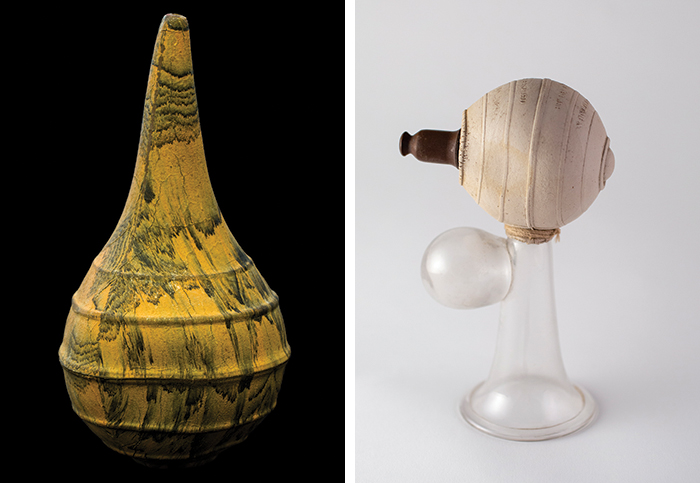Lindsey Beal
Lindsey Beal invites me into her home/studio, a rare single-family house in the bustling Fox Point neighborhood of Providence. Her living room is hip yet lived-in, decorated with mod graphic posters, children’s toys tucked away but still part of the landscape. This juxtaposition of aesthetic care and everyday life is integral to Beal’s work: Her practice and studio both embody the permeable border between art and life intrinsic to her photography.

Beal exposing a cyanotype in her backyard. Image courtesy of the artist.
Beal’s basement studio is a cozy home to her papermaking press, UV exposure box and several other contact print tools. “My space isn’t fancy, but it is flexible!” Right away Beal speaks about the advantage of her home studio spaces, which include the basement, a corner of her upstairs bedroom dedicated to her digital editing and the backyard, where she does natural light exposures. As a new mother, she can work during nap time, and, of course, saving on studio rent is a bonus.
Her upstairs studio is reserved for digital editing and research, her desk obscured by papers, the brainstorming board above her desk lists upcoming exhibitions, grant opportunities and research ideas. Her most recent award is a two-year Andrew Mellon faculty fellowship at the RISD Museum’s Print Room, where she has taught alternative photographic and papermaking processes. From her densely covered desk, she pulls a box of slides from her Parturition series, an elegant example of past and present merged in practice. The plates live in an industrial black box, but when displayed on her wooden light box, they reveal a catalogue of historical gynecological and obstetric tools. Parturition invites the viewer to rifle through the slides, to hold, illuminate and examine them, insisting on the object quality of both the photographs and the tools they depict. The digital photographs, printed on modern plexiglass, recall 19th-century medical documentation—one of the first disciplines to adopt and invest in the supposed truth- telling capacities
of the photograph.

Parturition: Bulb Feeder, 2016–2018, 4 x 5″, digital print on plexiglass plate. Bulb feeder (c. early 20th century) sourced from Yale University’s Harvey Cushing/John Hay Whitney Medical Library. Above, right: Work in progress for Beal’s Feed series, Untitled, 4 x 5″, digital print on plexiglass plate, 2019, documenting a bicycle pump/breast pump (c. 1879) sourced from Yale New Haven Hospital Archives, Howard D. Fink Collection, 2018. These two bodies of work are meant to work in dialogue with one another. Images courtesy of the artist.
Beal remarks that she conceptualized the project about six years ago, when many of her friends were having babies. While she began research for the series during Obama’s presidency, she completed her editing process during the current administration, as women’s autonomy around reproductive health has become increasingly at risk, with Planned Parenthood clinics being defunded and closed across the country.
Beal’s current project, inspired by her experience as a nursing mother, investigates and records the tools of infant care, imagined from infant feeders (baby bottles) to nipple shields in cataloguing fashion similar to Parturition. She remarks that it’s comparatively challenging to find source artifacts for her next project. “While doctors would donate their tools to libraries or museums, things like nipple shields would just get thrown out.” This series, tentatively titled Feed, may also incorporate her recent video work, which depicts the intricate movements of the microscopic bacteria in different recipes for infant formula. Just like she did with Parturition, Beal looks to tools to represent the body and its lived experience without further objectifying the feminine form.
Recently, Beal has started a collaboration with Rhode Island–based papermaker May Babcock (featured in Art New England’s coverage of the ReSeeding the City exhibition in the September/October 2019 issue). Their current work explores painting with cyanotype, exposing images and patterns on paper made from local invasive species and experimenting with gilding—a gorgeous combination of the unusual textures and colors of the paper set off by the rich cyan of the contact prints. This shift, too, is about photography and life. Cyanotype chemicals neutralize during processing so they can be disposed of safely and with ease, which makes the process more sustainable for the environment and aligns with Beal’s health concerns as she ages and cares for her child.
Like photography, Beal’s practice is a process. As she walks me out through the backyard, she reflects how lucky she is to have the space for both work and play in such a densely populated neighborhood of the city. Her multi-faceted studio makes physical the idea of having room for different practices, all intertwined with her daily life.
Elizabeth Maynard is a member of the faculty at RISD and Rhode Island College. Her recent research and writing focuses on modern and contemporary art with a lens towards somatics and the (de) constructions of subjectivity.
